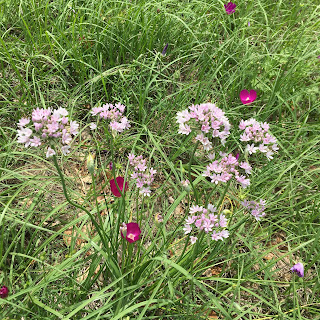Yesterday was a perfect day
for beekeeping in southeast Texas with blue
skies, low humidity and temps in the mid-70s.
We love escaping Houston for a day trip to the countryside where we
keep our bees, and being outside in this great weather is icing on the cake! (Click on photos to enlarge)
 |
Wild onion and wine cups.
|
 |
| The bees' view from their landing boards. |
 |
Stomping grounds for nectar collection.
|
 |
Wine cups speckle the grassy countryside.
Our hives are off in the distance.
|
 |
Beekeeper Mark with our bees.
|
 |
Phlox, Indian paintbrush and dandelions
(among many other wildflowers) are at our bees' front door.
|
Our colony in hive 01 is
very healthy and growing, so we added a super for the bees to continue to
increase their honey production.
 |
Hive 01 prior to inspection.
|
 |
Frame of comb from hive 01. Notice that the bees have created a bunch of new comb
on the far right, near the top of the frame. This is out of place because during
our last visit, we did not push the frames close enough together.
The bees took advantage of the extra space and built comb to fill it up. |
We saw our queen in hive
02. This colony is slow-growing and not
producing much honey. We decided to wait
a little longer to add a second deep hive box, as the bees still need to build
a couple more frames of honeycomb.
 |
| Can you find the queen? |
The colony in hive 03 looks
perfect. One super is mostly filled with honey, but it needs to be capped. The
two deep supers are practically welded together with propolis that the bees create to use like mortar. We could not
pull the frames out to inspect inside the boxes without doing damage to their frames. But, we aren’t worried though, as the population
is good and they have made a lot of honey for us…signs that all is good below.
 |
This plastic grid is a queen excluder. While the worker bees are small enough
to fit through the holes, the queen is not. She stays below the grid to lay her eggs.
Boxes placed on top of the grid will contain only honey.
|
 |
The bees don't know it, but they are making this honey
for us to take home soon!
|
 |
Notice the brown squiggly lines on the tops of the frames.
This is propolis that the bees created. They noticed the queen excluder
and fill the gaps on the underside of it with propolis. They do this all
around the inside of the hive box to seal it, protecting the colony from
pests and from weather.
|
In hive 05, the bees have
built comb in the super and are filling it with a tiny bit honey. Their top deep is
stuffed full with honey.
 |
Hive 05 has a front-row seat to the blooming flowers.
|
 |
Hive 05 bees have built comb on this frame in the super.
The are working together to place honey inside the cells of the comb.
|
 |
Bees are nestled in their deep hive box between their frames,
resting on their capped honey. |
Well, we did not find a
queen in hive 06. This wasn’t too
surprising as we were taking a chance that one of the several virgin queens would
triumph, but none did. The top deep hive had many bees, though.
We think these bees were the last remaining in the colony (and not
robber bees) and will soon perish without a queen.
At this point, it is too late to save hive 06. The honey stores are in poor shape and there is
no future generation to sustain them.
The
bottom deep hive box was completely empty of bees, honey and pollen, but the
comb was in great shape. We took the top
deep hive box, still full of bees, and placed it directly on the landing board
and removed the bottom deep hive box, thinking that we might add it to hive 07,
if needed.
 |
Hive 06 had two deep hive boxes before inspection.
|
 |
Hive 06 frame with bad honey and pollen.
The honey is too wet and has fermented, making it useless.
|
 |
| Bottom deep hive box of hive 06 is empty, except for comb. |
Hive 07 had only one deep
hive box. It is in similar shape as hive
02…slow-growing. We decided to add the
deep hive from the 06 colony with hopes they will continue to grow.
 |
Hive 07 prior to inspection. Dandelions close by.
|
 |
| Hive 07 queen. |
Hive 08 is very healthy. It has two deep hive boxes and we added a
medium super during our visit. I think I got a quick glimpse of the queen, but it
happened so quickly, so I wasn’t certain it was her or a drone. However, there was capped brood and that is always a
good sign.
 |
Hive 08 frame with capped honey near the top.
Some capped brood is yet to hatch. |
We
are at the peek of the nectar flow season and there is still a lot of work for
our bees to do. There are so many
flowers covering the countryside for them.
 |
| Texas thistle. |
 |
Buttercups are found all throughout southeast Texas.
|
 |
Phlox is thick in this area.
|
 |
| Indian paintbrush in the bees' front yard. |

























Comments
Post a Comment